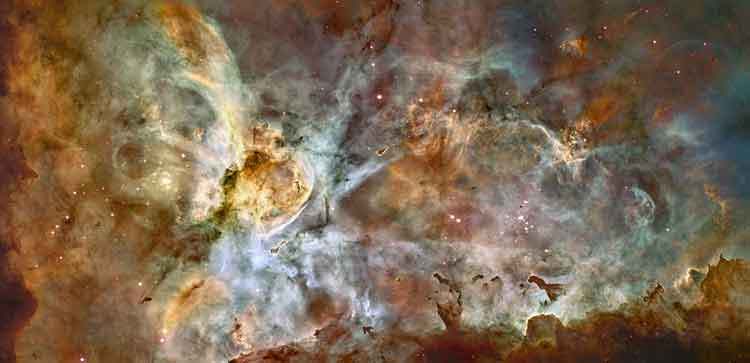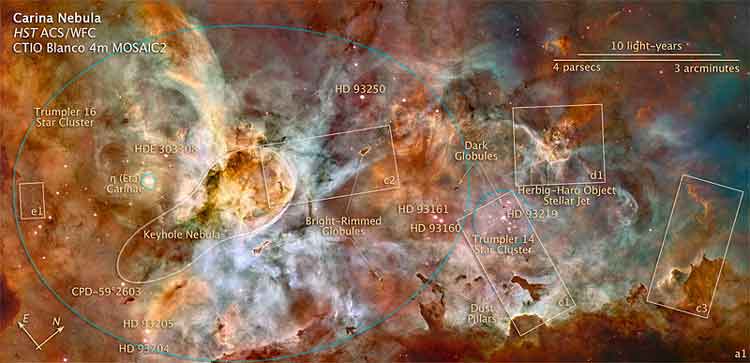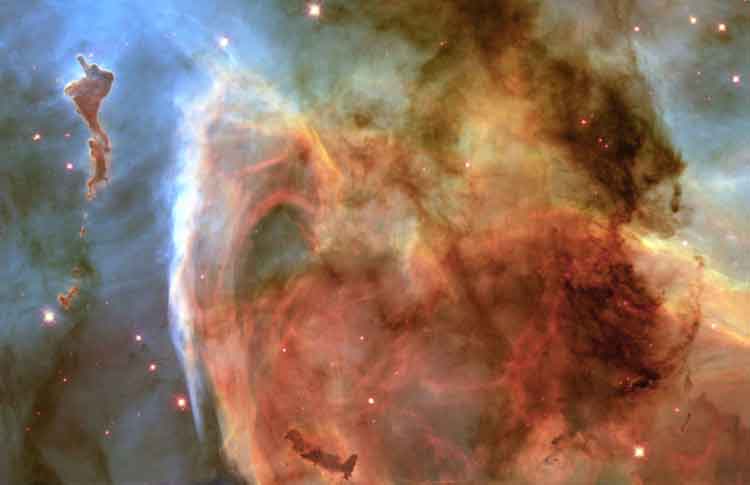
A Hubble Space Telescope (HST) image of NGC 3372. The image is 50 light-years wide and a composite of 48 frames. The false color image was created using the following formula: red for sulfur, green for hydrogen, and blue for oxygen emissions.
The Carina Nebula (also known as the Great Nebula in Carina, the Eta Carinae Nebula, or NGC 3372) is a large bright nebula that surrounds several open clusters of stars. Eta Carinae and HD 93129A, two of the most massive and luminous stars in our Milky Way galaxy, are among them. The nebula lies at an estimated distance between 6,500 and 10,000 light years from Earth. It is located in the constellation of Carina. The nebula contains multiple O-type stars.
Observation data: J2000.0 epoch
Type Emission
Right ascension 10h 44m 19.0s[1]
Declination -59° 53′ 21″[1]
Distance ~8000 ly
Apparent magnitude (V) +1.0
Apparent dimensions (V) ??? arcmins
Constellation Carina
Physical characteristics
Radius ???
Absolute magnitude (V) ???
Notable features Includes dark nebula
Keyhole Nebula
Other designations NGC 3372[1]
See also: Diffuse nebula, Lists of nebulae
This nebula is one of the largest H II regions in the Milky Way. It has a visual magnitude of 1.0. The astronomical coordinates are:
* R.A.: 10h 43.8m
* Dec.: −59° 52'
The nebula is one of the largest diffuse nebulae in our skies. Although it is some four times as large and even brighter than the famous Orion Nebula, the Carina Nebula is much less well known, due to its location far in the Southern Hemisphere. It was discovered by Abbé Lacaille in 1751–52 from the Cape of Good Hope.
Within the large bright nebula is a much smaller feature, immediately surrounding Eta Carinae itself. This small nebula is known as the Homunculus Nebula (from the Latin meaning Little Man), and is believed to have been ejected in an enormous outburst in 1841 which briefly made Eta Carinae the second-brightest star in the sky.
Objects within the Carina Nebula

A Hubble Space Telescope (HST) image/diagram of the of Carina Nebula (Zoomable version); Credit: HST/NASA/ESA
Eta Carinae
Main article: Eta Carinae
Eta Carinae is a highly luminous hypergiant star. Estimates of its mass range from 100–150 times the mass of the Sun, and its luminosity is about four million times that of the Sun.
This object is currently the most massive star that can be studied in great detail. Several other known stars may be more luminous and more massive, but data on them is far less robust. (Caveat: Since examples such as the Pistol Star have been demoted by improved data, one should be skeptical of most available lists of "most massive stars." As of late 2006, Eta Carinae still has the highest confirmed luminosity, based on data across a broad range of wavelengths.) Stars with more than 80 times the mass of the Sun produce more than a million times as much light as the Sun. They are quite rare—only a few dozen in a galaxy as big as ours—and they flirt with disaster near the Eddington limit, i.e., the outward pressure of their radiation is almost strong enough to counteract gravity. Stars that are more than 120 solar masses exceed the theoretical Eddington limit, and their gravity is barely strong enough to hold in its radiation and gas, resulting in a possible supernova or hypernova in the near future.
Eta Carinae's effects on the nebula can be seen directly. The dark globules in the above image and some other less visible objects have tails pointing directly away from the massive star. The entire nebula would have looked very different before the Great Eruption in the 1840s surrounded Eta Carinae with dust, drastically reducing the amount of ultraviolet light it put into the nebula.
Keyhole Nebula

Keyhole Nebula, imaged by Hubble Space Telescope. The small nebula to the upper left has been nicknamed "finger of God" or "God's birdie", due to the sophomoric gesture it appears to be making.
A portion of the Carina Nebula is known as the Keyhole Nebula, a name given to it by John Herschel in the 19th century. The Keyhole Nebula is actually a much smaller and darker cloud of cold molecules and dust, containing bright filaments of hot, fluorescing gas, silhouetted against the much brighter background nebula. The diameter of the Keyhole structure is approximately 7 light years.
Its image has been used on the internet as a joke, due to the fact that it resembles a giant hand flipping the bird.
Carina Nebula
Links
* SEDS: The Eta Carinae Nebula
* NASA Astronomy Picture of the Day: The Great Nebula in Carina - July 19, 1999
* The ESA Hubble Space Telescope site: Results for the Carina Nebula
References
1. ^ a b c SIMBAD Astronomical Database. Results for NGC 3372. Retrieved on 2007-04-26.
Retrieved from "http://en.wikipedia.org/"
All text is available under the terms of the GNU Free Documentation License

